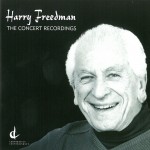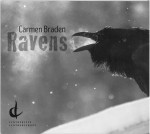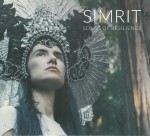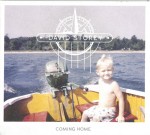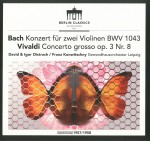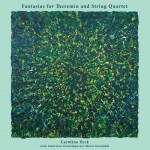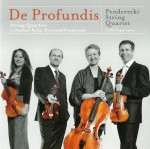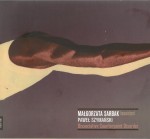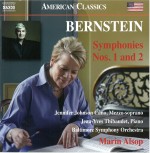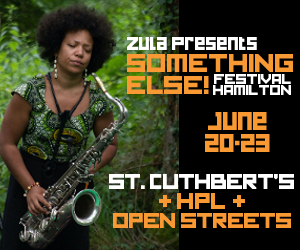Editor's Corner - April 2017
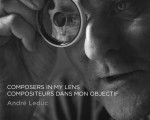 Composers In My Lens/Compositeurs dans mon objectif (Canadian Music Centre ISBN 978-1-77136-056-2) presents a photographic journey through the world of Canadian music as documented by André Leduc over the past three decades. I might be considered too close to the subject to write about this book, but on the other hand that is exactly why I need to tell the story. I first met my good friend André in 1986 at an Esprit Orchestra concert at Jane Mallett Theatre. One of the most outgoing people I have ever encountered, he just wandered up and started talking about the concert, the music, life and himself. At that point I had been producing and hosting Transfigured Night at CKLN-FM, a program focusing on contemporary music, for a couple of years and it was a treat to meet someone who shared my love of that esoteric medium. We became fast friends and for the next five years while the show ran its course, he was my number one fan. So there is my full disclosure/due diligence done.
Composers In My Lens/Compositeurs dans mon objectif (Canadian Music Centre ISBN 978-1-77136-056-2) presents a photographic journey through the world of Canadian music as documented by André Leduc over the past three decades. I might be considered too close to the subject to write about this book, but on the other hand that is exactly why I need to tell the story. I first met my good friend André in 1986 at an Esprit Orchestra concert at Jane Mallett Theatre. One of the most outgoing people I have ever encountered, he just wandered up and started talking about the concert, the music, life and himself. At that point I had been producing and hosting Transfigured Night at CKLN-FM, a program focusing on contemporary music, for a couple of years and it was a treat to meet someone who shared my love of that esoteric medium. We became fast friends and for the next five years while the show ran its course, he was my number one fan. So there is my full disclosure/due diligence done.
A commercial photographer by trade, André is also a hobbyist with a passion for taking portraits and, more to the point, action shots of the composers whose music, he says, changed his life. With no formal training in music he simply follows his ears. For years he has told me that I was his inspiration but, as we have delved back into the depths of memory, it seems his road to Damascus moment actually predated our meeting by quite some time. While listening to Radio Canada one day he heard a piece by François Dompierre that struck him like a bolt of lightning and he was amazed to learn that it was written by a Canadian composer and, not only that, by someone who was still alive! Thus began his love of contemporary music and lifelong quest of “stalking the wild composer” in his lair, which proves what I’ve told him time and time again: “It’s not MY fault!” Although I do admit to being his fellow traveller over the past three decades, introducing him to composers featured on my radio program and later bringing him on as the photographer for New Music Concerts when I started there in 1999. But even there André had made his own inroads and had taken photographs for NMC for several years until a change of administration had brought that to an end long before my tenure. We also took road trips together, to Montreal, on one occasion for the founding of the Canadian Electroacoustic Community where we met a number of composers that are featured in the book – notably Francis Dhomont and Robert Normandeau – and another time to meet with Jean Papineau-Couture, and to Ottawa where we spent an enchanting afternoon with Violet Archer, but most of our adventures took place right here in Toronto.
André built a bond with many of the new music societies in town and the fruits of these relationships are on display in his marvellous book. The scope of the project spans generations – from composers born before the First World War: Murray Adaskin, Otto Joachim, John Weinzweig and Violet Archer; through the 1920s and 1930s: Harry Freedman, Harry Somers, John Beckwith, Gilles Tremblay, R. Murray Schafer, Norma Beecroft and Ann Southam; the 1940s and 1950s: John Rea, Alex Pauk, Alexina Louie, Gary Kulesha and Linda Bouchard; to those born in the 1960s and 1970s: Omar Daniel, James Rolfe, Allison Cameron, Chris Paul Harman, Brian Current and André Ristic – to name literally just a few. Each composer is presented in two frames, on facing pages, some candid and some obviously posed. Highlights for me include the iconic shot of Jean Papineau-Couture seated in front of an open orchestral score wearing a cravat and dress jacket adorned with his Order of Canada pin; Robert Aitken looking ferocious with his white mane, flute to his mouth and wearing the small, thick-framed glasses that were his trademark for so many years; Larry Lake lounging, drink in hand, with a big smile on his face wearing an embroidered shirt and swanky cowboy boots; and Lori Freedman caught in action with bass clarinet in hand (and mouth) and contrabass clarinet draped over her shoulder. As the saying goes, “every picture tells a story” and here we are presented with some intriguing tales of our musical heritage. The book is available from the CMC website at musiccentre.ca.
Other than two years of piano lessons begun when I was five which I was allowed to abandon after kicking and screaming during daily practise sessions throughout that period, my classical music studies did not begin until after high school. I mentioned in the last issue that I attended the somewhat experimental Thornlea Secondary School in its initial years and the music teacher there, Charles Lapointe, has had a lasting influence on me. Although we didn’t have any formal classical music in the curriculum – the school bands were a folk club, a mariachi band, a rock group and an electronic music studio – we were exposed to a broad spectrum of music, from Isaac Hayes’ Hot Buttered Soul to Honegger’s Pacific 231. “Charlie” was a cellist and in my effort to emulate him in the sabbatical year following graduation (at least that’s what my mom called it, I thought I was finished with schooling at that point) I decided to take up that lowest member of the violin family myself. I did this with cello lessons from Wolfgang Grunsky and music theory studies through the Royal Conservatory. I rapidly found that to even partially grasp the basic tenets of composition I would need to add keyboard to my skill set. I was fortunate that Thistletown where I grew up was home to a very accomplished piano teacher, Elska Albarda, who was sympathetic to my desire to ignore the syllabus and concentrate on Bach and Bartók, whose music had become central to my development. Incidentally, her husband, retired architect Jan Albarda, was an amateur harpsichord maker and when for a term-end recital one of my pieces was a Bach two-part invention I had the privilege of performing on an “original” instrument. While I pursued these formal studies for only a couple of years after high school, I did find myself going back to Mrs. Albarda some years later for a bit of remedial study. By this time she had relocated to idyllic Elora for her final decades – her legacy of a 1913 Rosler grand piano adorns the Elora Centre for the Arts – and I was living for the summer in a coach house in Guelph from which I commuted by bicycle for lessons. To my shame I never returned her copy of Arthur Alexander’s edition of those two-part inventions published by the Associated Board of the Royal Schools of Music, but every time I see her handwriting on the cover I have fond memories of our times together.
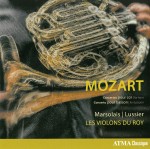 All this is by way of a long-winded introduction to my first CD selection for the month. At the time I was working on my RCM Grade 7 piano, my slightly younger brother Kevin, who was still in high school and had taken up the French horn, was working on one of the Mozart concertos and asked me to accompany him. Although I was simply not up to the challenge, it was an enlightening introduction to these great pieces. I remember my brother going to see Barry Tuckwell performing with the Toronto Symphony and explaining that, with an instrument comprised of 12 feet of coiled tubing, even the best horn players never really know for sure what note will come out. I don’t know if this was a commentary on Tuckwell’s performance or just a general statement. Be that as it may, if the new recording of the Mozart Horn Concertos with Les Violons du Roy (ATMA ADC2 2743) is any indication, Louis-Philippe Marsolais can be fairly confident of his ability to produce the right notes. Touted as Canada’s most active horn soloist, Marsolais is a multiple award-winner with an international solo and chamber career. Since 2009 he has also been principal horn in Yannick Nézet-Séguin’s Orchestre Metropolitain and is a frequent collaborator with Les Violons du Roy. As alluded to above, his intonation is impeccable and his tone is exemplary. This recording includes the three familiar concertos that Mozart completed, all in E-flat (Nos.2-4), plus the two-movement D-Major concerto known as No.1, here in Mozart’s original version completed by modern-day musicologist Robert D. Levin (as opposed to the version by Mozart’s coeval Franz Xaver Süssmayr). Also included is Levin’s edition of the lesser known Rondo K371 in E-flat Major. Marsolais provides his own convincing cadenzas in all five works. The disc is completed by the Concerto for Bassoon in B-flat Major K191 featuring the dulcet tone and impressive agility of Mathieu Lussier, who also serves as conductor for the entire project.
All this is by way of a long-winded introduction to my first CD selection for the month. At the time I was working on my RCM Grade 7 piano, my slightly younger brother Kevin, who was still in high school and had taken up the French horn, was working on one of the Mozart concertos and asked me to accompany him. Although I was simply not up to the challenge, it was an enlightening introduction to these great pieces. I remember my brother going to see Barry Tuckwell performing with the Toronto Symphony and explaining that, with an instrument comprised of 12 feet of coiled tubing, even the best horn players never really know for sure what note will come out. I don’t know if this was a commentary on Tuckwell’s performance or just a general statement. Be that as it may, if the new recording of the Mozart Horn Concertos with Les Violons du Roy (ATMA ADC2 2743) is any indication, Louis-Philippe Marsolais can be fairly confident of his ability to produce the right notes. Touted as Canada’s most active horn soloist, Marsolais is a multiple award-winner with an international solo and chamber career. Since 2009 he has also been principal horn in Yannick Nézet-Séguin’s Orchestre Metropolitain and is a frequent collaborator with Les Violons du Roy. As alluded to above, his intonation is impeccable and his tone is exemplary. This recording includes the three familiar concertos that Mozart completed, all in E-flat (Nos.2-4), plus the two-movement D-Major concerto known as No.1, here in Mozart’s original version completed by modern-day musicologist Robert D. Levin (as opposed to the version by Mozart’s coeval Franz Xaver Süssmayr). Also included is Levin’s edition of the lesser known Rondo K371 in E-flat Major. Marsolais provides his own convincing cadenzas in all five works. The disc is completed by the Concerto for Bassoon in B-flat Major K191 featuring the dulcet tone and impressive agility of Mathieu Lussier, who also serves as conductor for the entire project.
I had initially offered this disc to Alison Melville but found myself reneging when I gave it a listen. In the words of my apology to her: It’s a dandy! (She graciously responded that it was all right because the recording I had given her to review of these concertos several years ago with Pip Eastop and the Hanover Band was also a dandy.)
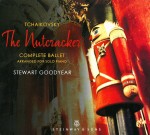 Another piece that harkens back to my formative years is Tchaikovsky’s The Nutcracker although my exposure, like that of so many others I’m sure, was just to the eight-movement Suite Op.71a. My introduction was on a 3-LP Seraphim set of suites from the ballets Swan Lake, Sleeping Beauty and The Nutcracker performed by the Philharmonia Orchestra under Efrem Kurtz. No wonder then that so many of the 24 tracks on Stewart Goodyear’s transcription for solo piano of the entire ballet (Steinway & Sons 30040) seem unfamiliar. Somehow we missed this disc, recorded in February 2015, when it came out. Since then two Christmases, the traditional Nutcracker time, have come and gone. Rather than wait another year I want to tell you about this new approach to what is indeed a timeless classic.
Another piece that harkens back to my formative years is Tchaikovsky’s The Nutcracker although my exposure, like that of so many others I’m sure, was just to the eight-movement Suite Op.71a. My introduction was on a 3-LP Seraphim set of suites from the ballets Swan Lake, Sleeping Beauty and The Nutcracker performed by the Philharmonia Orchestra under Efrem Kurtz. No wonder then that so many of the 24 tracks on Stewart Goodyear’s transcription for solo piano of the entire ballet (Steinway & Sons 30040) seem unfamiliar. Somehow we missed this disc, recorded in February 2015, when it came out. Since then two Christmases, the traditional Nutcracker time, have come and gone. Rather than wait another year I want to tell you about this new approach to what is indeed a timeless classic.
In the words of the performer/arranger “You can look at The Nutcracker as the Walt Disney of music. It enchants on the same levels as Disney does: there’s the humour; for some, there’s the love story; for some, adventure. All those aspects are there: it’s like listening to Technicolor, listening to animation.” You would be forgiven for thinking that Tchaikovsky’s gorgeous orchestration which incorporates so many colours into its palette might suffer in translation to a single instrument, and for that matter a single performer. But I’m here to tell you that Goodyear’s thoughtful treatment and virtuosic flamboyance give the lie to this. “I’m just trying to create as faithful an arrangement as possible” says Goodyear, “with all of the orchestral elements there – the woodwinds, the brass, so it doesn’t feel like the audience is missing anything – it’s all there.” I would have to say that he succeeds. And when I said just a single instrument, I will note that there is one exception to this: At the outset of the pitched battle between the Nutcracker and the Mouse King we are momentarily startled by the sharp crack of a slapstick which announces the Keystone Kops-like action sequence. All in all, this is an outstanding and exhilarating achievement and I’m sorry it took so long to come to my attention. Insider’s note: Goodyear’s next recording features works by Maurice Ravel (Jeux d’eau; Sonatine; Miroirs, Gaspard de la nuit and Pavane pour une enfant defunte) and will be released by Orchid Classics in May.
 Elsewhere in these pages you will find Bruce Surtees’ appreciation of the Berlin Philharmonic’s production of the St. Matthew Passion directed by Peter Sellars. I kept the companion set, Johann Sebastian Bach: Johannes-Passion (Berliner Philharmoniker Recordings BPHR 140031, 2 DVDs and 1 Blu-ray disc) for myself and I will echo Bruce’s opinion that one should start with the bonus features. In Andy King-Dabbs’ interview with conductor Sir Simon Rattle and stage director Peter Sellars, he asks each about their first encounters with the work. My own was a sort of epiphany. As an aspiring cellist, in my middle years I joined CAMMAC (Canadian Amateur Musicians) one summer and headed off to music camp in Quebec for an intensive week of music making with about 100 other amateurs under the supervision of some very accomplished professionals. (As a matter of fact, one of my chamber music coaches was violinist Michelle Seto who, I see from the personnel list on the Mozart disc mentioned above, is still a core member of Les Violons du Roy.) Check-in at the camp – a rustic lodge on the edge of Lake MacDonald – was on a Sunday afternoon and our first musical gathering took place that evening. It was my first experience of playing in a large ensemble and I approached it with equal amounts of excitement and trepidation. The music set before us was the opening chorale from the St. John Passion. Although the repeated note that constitutes most of the cello line is quite straightforward, I was concentrating on it with all my energy to the exclusion of my surroundings. When from behind the orchestra the choir suddenly burst forth with Herr, Herr, Herr, Herr unser Herrscher it was a truly glorious moment and I found myself thinking “Wow, this is amazing!” I’ve been hooked on making music with others ever since.
Elsewhere in these pages you will find Bruce Surtees’ appreciation of the Berlin Philharmonic’s production of the St. Matthew Passion directed by Peter Sellars. I kept the companion set, Johann Sebastian Bach: Johannes-Passion (Berliner Philharmoniker Recordings BPHR 140031, 2 DVDs and 1 Blu-ray disc) for myself and I will echo Bruce’s opinion that one should start with the bonus features. In Andy King-Dabbs’ interview with conductor Sir Simon Rattle and stage director Peter Sellars, he asks each about their first encounters with the work. My own was a sort of epiphany. As an aspiring cellist, in my middle years I joined CAMMAC (Canadian Amateur Musicians) one summer and headed off to music camp in Quebec for an intensive week of music making with about 100 other amateurs under the supervision of some very accomplished professionals. (As a matter of fact, one of my chamber music coaches was violinist Michelle Seto who, I see from the personnel list on the Mozart disc mentioned above, is still a core member of Les Violons du Roy.) Check-in at the camp – a rustic lodge on the edge of Lake MacDonald – was on a Sunday afternoon and our first musical gathering took place that evening. It was my first experience of playing in a large ensemble and I approached it with equal amounts of excitement and trepidation. The music set before us was the opening chorale from the St. John Passion. Although the repeated note that constitutes most of the cello line is quite straightforward, I was concentrating on it with all my energy to the exclusion of my surroundings. When from behind the orchestra the choir suddenly burst forth with Herr, Herr, Herr, Herr unser Herrscher it was a truly glorious moment and I found myself thinking “Wow, this is amazing!” I’ve been hooked on making music with others ever since.
The Berlin production is semi-staged, but as Rattle explains it is more of an elaboration of the text, a ritualization rather than a theatrical presentation of the story. Although written by Bach for church performance on Good Friday, the St. John Passion goes far beyond the bounds of the usual church service and caused, if not scandal, at least disgruntlement among the conservative congregations of Bach’s time, so it is a work which has no natural forum in church due to its theatrical aspects nor the opera house where its liturgical nature is forbidden. This is well explained in the interview and also in the enlightening introduction provided by Simon Halsey, director of the Berlin Radio Choir, who puts not only the original but also this somewhat contemporary interpretation of the work into context. Frequently judged for its anti-Semitic sentiments placing all the blame for Christ’s death on the Jews, this presentation of the Passion takes a more universal approach in which the blame is shared with everyone. Halsey points out that the onus is on each of us to take a stand and speak out against injustice when we see it and likens the situation to the events that led to the First and Second World Wars. (Sellars goes farther, comparing it to the current affairs of his American homeland.)
The Berlin Philharmonie where the performance takes place provides a theatre-in-the-round and Sellars has used this to good advantage. The orchestra – playing on modern instruments, but well informed by historical practices – is divided in two and the instrumentalists move to prominent spots when used as soloists. The continuo consists of cello, organ, lute, contrabass, bassoon and contrabassoon, and this is supplemented with viola da gamba and two violas d’amore as the score requires. The choir, 90 voices strong, is dressed in black and called upon to make some dramatic movements, including writhing on the floor and a making hand gestures. Although off-putting at first, the effects gradually draw us in and become an inherent part of the drama as it unfolds. All of the vocal soloists are outstanding, but particular mention must be made of Mark Padmore (Evangelist), Christian Gerhaher (Pilate) and Roderick Williams (Jesus) who is blindfolded and in uncomfortable positions through much of the action. It is worthy of note that all the vocalists, soloists and choristers (!) alike sing for the entire two hours from memory, and Rattle conducts without a score. This is a stunning production and I highly recommend it.
Concert note: On April 1 the Guelph Chamber Choir presents the St. John Passion with James McLean (Evangelist), Daniel Lichti (Jesus), Gordon Burnett (Pilate) and Orchestra Viva under Gerald Neufeld’s direction at the River Run Centre in Guelph. On April 2 it will be presented in Toronto by the Choir of St. Peter and St. Simon-the-Apostle Anglican Church with Lenard Whiting (Evangelist) and members of the Canadian Sinfonietta, Robin Davis conducting.
We welcome your feedback and invite submissions. CDs and comments should be sent to: DISCoveries, WholeNote Media Inc., The Centre for Social Innovation, 503 – 720 Bathurst St. Toronto ON M5S 2R4. We also encourage you to visit our website “thewholenote.com” where you can find enhanced reviews in the Listening Room with audio samples and direct links to performers, composers and record labels.
David Olds, DISCoveries Editor
discoveries@thewholenote.com


